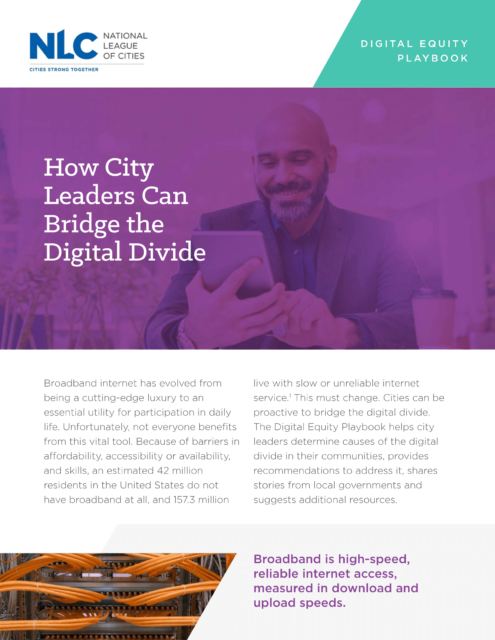
What federal resources can cities use to fund digital equity?
Various financing and funding options for digital equity efforts are available. Many state and federal funding sources, particularly those established in response to the COVID-19 pandemic, are limited in amount or program duration and may not be available permanently. City leaders should verify all funding information.
Cities can use federal grant and loan programs to support local digital equity work, from needs assessment, to network infrastructure construction, to digital skills training, and broadband device and subscription affordability assistance for residents. The National Telecommunications and Information Administration (NTIA) maintains a record of all federal funds that cities can use for broadband. The list below includes some of the key programs available to communities.
Federal Communications Commission Universal Service Fund Programs
The Federal Communications Commission oversees the Universal Service Fund (USF) to promote broadband development and adoption through four targeted problems administered by the Universal Service Administrative Company (USAC). The FCC’s Schools and Libraries program, better known as E-rate, provides discounts for telecommunications and information services, internal connections and basic connection maintenance to schools and libraries. Discounts range from 20 to 90 percent, based on how many students are eligible for free or reduced-price lunch. E-rate supported services are limited to educational services and on-campus use.143
Emergency Connectivity Fund
The American Rescue Plan Act (ARPA) established a $7.1 billion Emergency Connectivity Fund (ECF) to help schools and libraries support remote learning. The ECF will enable eligible schools and libraries to purchase Wi-Fi hotspots, modems, routers and connected devices. Schools and libraries can also reimburse households for internet service that students need to participate in remote learning. The $7.1 billion will be funneled through the FCC’s current E-rate program for schools and libraries. However, there are key differences between this new funding and previous E-rate funding. Traditionally, E-rate funds were limited to on-campus use. Now, schools and libraries can use E-rate funds through the ECF to support students off campus.
Lifeline
Unlike other USF programs, the Lifeline program directly supports individuals. The program provides monthly discounts to low-income consumers for phone and broadband services and is available in every state, commonwealth and on tribal lands. To participate, subscribers must have income that is at or below 135 percent of federal poverty guidelines. Many cities have dedicated significant resources to ensure that their low-income residents enroll in the program.144 A family that qualifies for Lifeline will also qualify to receive the Emergency Broadband Benefit, discussed below.
Emergency Broadband Benefit
Congress appropriated $3.2 billion for a new Emergency Broadband Benefit (EBB) program, which the FCC will administer.145 The EBB provides eligible low-income households with a monthly $50 discount for broadband service and a $100 discount on an internet-enabled device, such as a laptop, desktop computer or tablet. Eligible tribal households receive a $75 monthly discount for broadband service. The FCC will directly reimburse participating internet service providers. However, this program is temporary and will last only until the money runs out or until six months after the end of the COVID-19 public health emergency, whichever comes first. Although most local governments will not receive direct payments through the EBB unless they are participating internet service providers, local governments can help to ensure that eligible residents know of and receive benefits from this federal program.
American Rescue Plan Act and Local Coronavirus Fiscal Recovery Fund
The ARPA provides $65.1 billion in direct flexible grant support to every municipal government in the nation, to spend in various ways, including necessary investments in water, sewer or broadband infrastructure.146 The rules for the fund allow cities to spend grant dollars on broadband infrastructure in certain areas and to provide assistance to households facing negative economic impacts due to COVID-19. This assistance could include digital literacy training, paying for broadband subscriptions or devices and other programs that promote internet access.147 Funds must be committed by December 31, 2024, and spent by December 31, 2026. Cities do not need to participate in a competitive grant process to receive these funds but must meet reporting obligations when using Local Fiscal Recovery dollars.
Other Federal Funds
Cities may be able to leverage other federal grant and loan programs to support digital equity work. The Infrastructure Investment and Jobs Act provides more than $65 billion to promote broadband access through new infrastructure and digital equity grant programs, some of which are directly accessible to local governments. Additionally, cities can use Community Development Block Grants to conduct broadband needs assessment; install wiring, fiber optic cables, and permanently affixed equipment; and provide digital literacy classes, among other activities. The U.S. Department of Agriculture’s Rural Utilities Service offers a mix of grants and loans that telecommunications providers can use to build broadband infrastructure in rural areas. Cities can use Workforce Innovation and Opportunity Act (WIOA) funds to support digital skills and digital literacy training. Cities may also be able to access federal funds for which they are not otherwise directly eligible, by partnering with local institutions or organizations, including universities, school and library systems, and local internet service providers. Many federal programs are also administered primarily through state offices. Local governments unable to access federal broadband funding directly may be eligible to participate in state funding or financing programs.
Get the Federal Resources for Funding Digital Equity summary for the Digital Equity Playbook.
Learn how you can bridge the digital divide in your city.
Who does the digital divide affect?
Authors
- Lena Geraghty, Program Director, Urban Innovation, Center for City Solutions
- Angelina Panettieri, Legislative Director, Information Technology and Communications, Federal Advocacy
- Joshua Pine, Senior Specialist, Urban Innovation, Center for City Solutions
- Lindsey Volz, Graduate Intern, Center for City Solutions
Acknowledgements
The National League of Cities (NLC) is the voice of America’s cities, towns and villages, representing more than 200 million people. NLC works to strengthen local leadership, influence federal policy and drive innovative solutions.
NLC’s Center for City Solutions provides research and analysis on key topics and trends important to cities, creative solutions to improve the quality of life in communities, inspiration and ideas for local officials to use in tackling tough issues, and opportunities for city leaders to connect with peers, share experiences and learn about innovative approaches in cities.
Special Thanks
- Amy Robinson and Christian Hecht, Harvard Law School Cyberlaw Clinic Students, and Professor Susan Crawford for their research and contributions to this report.
- Meghan McDermott, Director of Digital Inclusion and Partnerships, City of New York, NY; Amelia Muller, Civic Design Principal, City of Birmingham, AL; Ramya Sankar, Innovation Technology Analyst, City of San Leandro, CA; Christopher Mitchell, Director, Community Broadband Networks Institute for Local Self-Reliance; Dozmen Lee, Outreach Coordinator, Institute for Local Self-Reliance; Angela Siefer, Executive Director, National Digital Inclusion Alliance; Miles Miller, Program Associate, National Digital Inclusion Alliance for their review of this report.
- Ashleigh Imus for copyediting.

